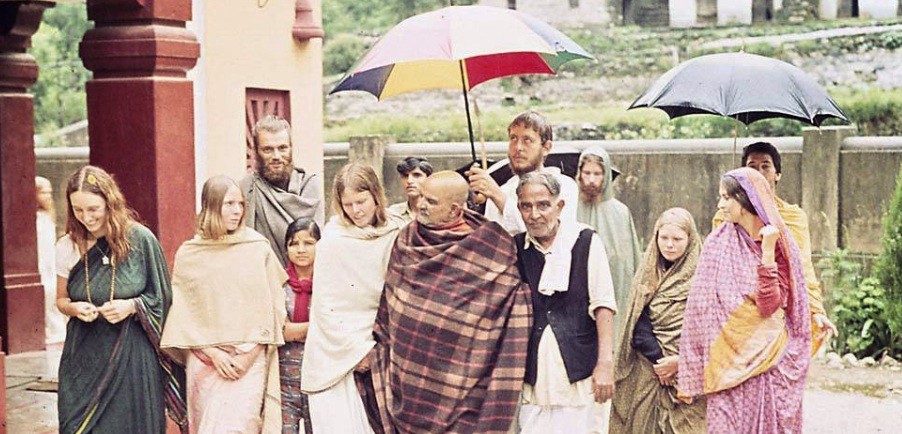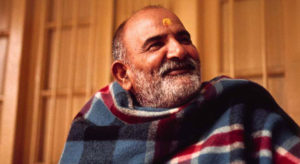The Guru-Disciple Relationship and the Complications of Consent
Is a devotee who promised to serve a guru able to assert her defiance or her consent?
 Recently, a story circulated on social media that many people reacted to as yet another example of a Hindu guru sexually abusing one of his devotees. The story was a devotee’s account of her sexual and violent interactions with Neem Karoli Baba, famed guru to the stars of the American counterculture. But this recently circulated version omitted sections of the original narrative, critical segments that complicate a facile black and white story of abuse and productively introduce the idea of “gray rape.” Gray rape acknowledges the messiness of sexual interactions, the competing discourses of normal sex (by which we establish what constitutes sexual violation), and differences in power and positionality that disallow a priori notions of consent. In what follows, I aim to illustrate the impossibility of a universal standard of consent that can be dislocated from the social context in which it is enacted and the power relations that inform it.
Recently, a story circulated on social media that many people reacted to as yet another example of a Hindu guru sexually abusing one of his devotees. The story was a devotee’s account of her sexual and violent interactions with Neem Karoli Baba, famed guru to the stars of the American counterculture. But this recently circulated version omitted sections of the original narrative, critical segments that complicate a facile black and white story of abuse and productively introduce the idea of “gray rape.” Gray rape acknowledges the messiness of sexual interactions, the competing discourses of normal sex (by which we establish what constitutes sexual violation), and differences in power and positionality that disallow a priori notions of consent. In what follows, I aim to illustrate the impossibility of a universal standard of consent that can be dislocated from the social context in which it is enacted and the power relations that inform it.
To do so, I first introduce the redacted account that recently circulated on social media and that generated outrage. Second, I add the omitted sections from this account and show how they produce a more complex narrative, dependent on the values and perspectives of the people involved. This version leads us into the muddy waters of real human interactions, ones that are fraught and complex, contradictory and unclear. In this particular case, the devotee recounting the story is anonymous and the guru in question is dead. What can we know of their actions and intentions, or how coercion and consent overlapped and intertwined? This is all the more important when the narrative is located within the social context of the Hindu guru-disciple relationship, a relationship entirely dependent on unequal power relations, wherein the guru is respected as a spiritual master and it is the disciple’s duty to submit to his authority.
Here is the recently circulated version that appeared on social media and that was previously published in the exposé volume, Stripping the Gurus:
The first time he [Guru Neem Karoli Baba] took me in the room alone I sat up on the tucket [low wooden bed] with him, and he was like a seventeen-year-old jock who was a little fast! I felt as if I were fifteen and innocent. He started making out with me, and it was so cute, so pure. I was swept into it for a few moments—then grew alarmed: “Wait! This is my guru. One doesn’t do this with one’s guru!” So I pulled away from him. Then Maharajji [Neem Karoli Baba] tilted his head sideways and wrinkled up his eyebrows in a tender, endearing, quizzical look. He didn’t say anything, but his whole being was saying to me, “Don’t you like me?”
But as soon as I walked out of that particular darshan [the ritual act of seeing and being seen by the divine], I started getting so sick that by the end of the day I felt I had vomited and shit out everything that was ever inside me. I had to be carried out of the ashram [religious hermitage]. On the way, we stopped by Maharajji’s [Neem Karoli Baba’s] room so I could pranam [prostrate] to him. I kneeled by the tucket and put my head down by his feet—and he kicked me in the head, saying, “Get her out of here!” . . .
That was the first time, and I was to be there for two years. During my last month there, I was alone with him every day in the room . . . Sometimes he would just touch me on the breasts and between my legs, saying, “This is mine, this is mine, this is mine. All is mine. You are mine.” You can interpret it as you want, but near the end in these darshans, it was as though he were my child. Sometimes I felt as though I were suckling a tiny baby.
***
In many ways, Neem Karoli Baba was a humble guru with simple teachings, but he became internationally renowned because of his disciples’ fame. He cultivated a cherished devotional space in the late 1960s and 1970s at his ashram in the Himalayan foothill town of Nanital, India, which Parvati Markus chronicled in her book Love Everyone. Neem Karoli Baba’s story often begins with the litany of Western devotees who became highly influential people after their encounters with him. Bhagavan Das and Ram Dass became his disciples and, later, gurus in their own right; Ram Dass inspired a generation with his pathbreaking publication Be Here Now.

Neem Karoli Baba
In 1973, Robert Friedland met Neem Karoli Baba and was so impressed with the simple, giggling guru that he told his friend Steve Jobs to go to India to meet him. Jobs went to see the guru and, as recounted in his biography, said, “For me it was a serious search. I’d been turned on to the idea of enlightenment and trying to figure out who I was and how I fit into things.” Forty years later, when Jobs met another tech-entrepreneur experiencing difficult times, he suggested that he, too, should travel to the ashram in Nanital. Mark Zuckerberg followed his advice. At a town hall with Indian Prime Minister Narendra Modi at Menlo Park, Zuckerberg explained, “He [Jobs] told me that in order to reconnect with what I believed as the mission of the company, I should visit this temple that he had gone to in India early on in his evolution of thinking about what he wanted Apple and his vision of the future to be.” He explains that his month-long trip to India “reinforced for me the importance of what we were doing.” Google’s founder Larry Page visited Neem Karoli Baba, as did Ebay’s founder Jeffrey Skoll, Daniel Goleman, Larry Brilliant, Lama Surya Das, and the list goes on and on. Ma Jaya, the guru and AIDS activist, revered Neem Karoli Baba, and leading kīrtan musicians Jai Uttal and Krishna Dass have been publicly vocal about their devotion to him. After seeing a photo of Neem Karoli Baba, actress Julia Roberts began to practice Hinduism and has expressed reverence for the smiling guru of the Himalayan foothills.
The devotee’s account that opened this discussion was not hidden from these celebrants of the guru. In fact, it was published back in 1979 in Ram Dass’s widely read devotional book Miracle of Love: Stories about Neem Karoli Baba. On the cover, the guru, clad in his signature plaid woolen blanket, holds a tulip, his eyes cast to the side in peaceful reflection. When the book was published, the passage did not spark any significant critique of Neem Karoli Baba’s treatment of this female devotee. It also included several key sections that add to the complexity and ambiguity of the account. The deleted sections that did not appear in the recent story on social media are as follows:
…I was unable to move for the next three days, but after that I felt perfectly well again. And I had worked through a lot of my reactions to that darshan: revulsion, confusion, and so forth…
…There was a progression of comprehension. He seemed in one way to be turning me into a mother, helping me to understand that sex is okay…
…Although he didn’t change size physically, he seemed to become very small in my arms. It was a beautiful transformation…
While the narrative of sexual fondling and physical violence remains, it is buttressed by the devotee’s account that she soon felt “perfectly well again” and had processed her negative reactions. She realized that the guru was shaping her into a new identity as “a mother” with him as her child; she reports their sexual relationship felt “as though I was suckling a tiny baby” and suggests that through these sexual encounters Neem Karoli Baba was teaching her that “sex is ok.” The devotee diminishes the potential interpretation of the guru’s persona as that of an overpowering and violent male abuser by redefining his physical presence as that of a small child. She explains that “he seemed to become very small in my arms” and concludes that “it was a beautiful transformation.”
The addition of these sections draws a more complex picture. They tell of a devotee who finds spiritual lessons in her sexual encounter with her guru and willingly develops a relationship with him that is both maternal and sexual. Although at first she regards the sexual encounter as “so cute, so pure,” she simultaneously rejects his advances as inappropriate and unwanted. Thereafter, she feels revulsion to the extent that she becomes physically ill, but then ultimately continues the sexual relationship (presumably intermittently) for two years. These are the thickets that represent the complexity and ambiguity of gray rape.
 By contemporary conventions, it is striking that Ram Dass chose to include this passage in his celebratory book about the guru. He likely did so because his devotion to the guru was so complete that he did not find the guru’s motivations troubling. In the traditional Indic context of the guru-disciple relationship, the devotee does not question the guru, irrespective of the guru’s actions. As written in the Saurapurāṇa 15.33, “The guru remains as the authority to his pupil, regardless of how ignorant and immoral he might be.” Such strictures are so complete that devotees are not even to be in the presence of a critique of the guru. Manusṃṛti 2.200 reads, “When one hears of censure (parivāda, nindā) against his guru by others, he is supposed to either shut his ears with his hands, or leave the place.” If we recognize that the goal of the guru-disciple relationship is eradication of the devotee’s ego through submission to the guru’s will, then it makes sense why the devotee’s initial vocalization that the guru’s sexual touch was unwanted directly challenged the power dynamic of their relationship. It is this challenge to the structure of the relationship that elicited a disciplinary response from the guru (regardless of whether we believe that response was legitimate or not).
By contemporary conventions, it is striking that Ram Dass chose to include this passage in his celebratory book about the guru. He likely did so because his devotion to the guru was so complete that he did not find the guru’s motivations troubling. In the traditional Indic context of the guru-disciple relationship, the devotee does not question the guru, irrespective of the guru’s actions. As written in the Saurapurāṇa 15.33, “The guru remains as the authority to his pupil, regardless of how ignorant and immoral he might be.” Such strictures are so complete that devotees are not even to be in the presence of a critique of the guru. Manusṃṛti 2.200 reads, “When one hears of censure (parivāda, nindā) against his guru by others, he is supposed to either shut his ears with his hands, or leave the place.” If we recognize that the goal of the guru-disciple relationship is eradication of the devotee’s ego through submission to the guru’s will, then it makes sense why the devotee’s initial vocalization that the guru’s sexual touch was unwanted directly challenged the power dynamic of their relationship. It is this challenge to the structure of the relationship that elicited a disciplinary response from the guru (regardless of whether we believe that response was legitimate or not).
Even in the 1960s and 1970s there were rumors about Neem Karoli Baba’s distinctive and sometimes sexual relationships with women. Ram Dass introduces the special favor his guru showed to women by positioning Neem Karoli Baba as emblematic of Krishna, who in Hindu myths approached the gopīs (cowherdesses) as a child, playmate, and lover. Although many modern Krishna devotees portray Krishna’s sexuality as merely metaphorical, the texts are explicit in their detailed descriptions of Krishna’s amorous love play with the gopīs. The Rasa Lila recounted in the Bhagavata Purāṇa reads, “Certainly, he [Krishna] is the supreme Soul, though they [the gopis] knew him intimately as their lover. They relinquished their bodies composed of material elements, and any worldly bondage was instantly destroyed.” In Dass’s view, Neem Karoli Baba’s sexual relationships with women modeled these mythical encounters. Sexual relations with the guru were to be read as a part of their spiritual practice, “catalyst[s] to catapult them to God.”
Certainly, it is shocking for our modern and non-devotional sensibilities to hear of a guru “making out” with a devotee like a “seventeen-year-old jock” and then kicking that prostrating devotee in the head, presumably to punish her for rejecting his sexual advances. But this easy condemnation is an expression of our ethics, not those of the devotee, guru, or the devotional community. Positioning ourselves as external moral critics effectively silences this devotee and superimposes our worldview upon hers. We can only then understand her as deluded, “brainwashed,” a victim of “false consciousness,” and blinded by her devotion. In so doing, we position ourselves as moral authorities, enacting a theological imperialism based on our values of secular humanism, universal human rights, and appropriate behavior.
But we must unfurl a more complex story, one that takes into account the worldviews, perspectives, and social embeddedness of the various people involved. Centering victims’ experiences and perspectives is crucial even when they do not align with our moral values. In this case, doing so complicates the conventional reliance on consent as the barometer to determine whether a sexual violation has occurred. Though this devotee gave her consent, under what conditions and power relations was she able to assert her agency? What were the potential consequences of rejecting the guru’s sexual advances? And what sexual subjectivity did she have access to? In Rape and Resistance, philosopher Linda Alcoff writes, “Unwanted touch produces the sense of first-person subjectivity, it poses the question of my desire, it prompts a formation of will, or a reassertion of it.” Is a devotee who has promised to serve the guru–unconditionally–actually able to assert her will in defiance of the guru’s wishes? And if not, is there meaning in her consent?
Sexual violation is an interpretive process. Our experience of an encounter is conditioned by our socially embedded and embodied positionality. Even the language available to describe the experience is informed by our discursive context. Approaching this event in this light helps us to see clear distinctions between our interpretive framework and many devotees’ interpretive framework. For contemporary audiences (especially secular humanist critics), it is a clear case of sexual abuse. For devotees (or at least these particular devotees), it is the guru’s līlā (divine play) that affects positive spiritual transformation in ways beyond human comprehension. Of course, outsiders can choose to argue that this claim is merely a theological veneer for the nefarious aim of the guru’s sexual gratification, but we should not ignore these perspectives. Neither should we supplant them with our own moral standards. That which is deemed offensive and immoral is generated through discourse and shaped by our historical, social, and cultural context. Superimposing our own revulsions onto others, we lose vital explanatory components that would aid in understanding alternative worldviews. We also falsely presume that our own contemporary discourses of morality are universal.
Amanda Lucia is Associate Professor of Religious Studies at the University of California-Riverside. Her current research focuses on sexual abuse in guru-led religious communities, with emphasis on celebrity and the circulation of scandal in media. Her publications include White Utopias: The Religious Exoticism of Transformational Festivals (forthcoming 2020), Reflections of Amma: Devotees in a Global Embrace (2014), and numerous articles.
***
Published with support from the Henry R. Luce Initiative on Religion in International Affairs.